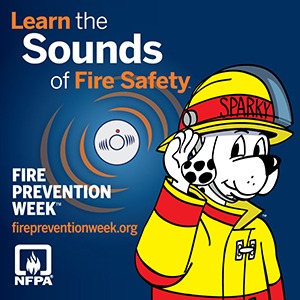
On October 9th, 1871, the Great Chicago Fire killed more than 250 people, left 100,000 homeless, destroyed more than 17,400 structures, and burned more than 2,000 acres of land. Every year in commemoration of the fire, Fire Prevention Week is observed. This year Fire Prevention Week is October 3rd – October 9th. During Fire Prevention Week, the goal is to spread awareness and educate the public about fire safety to prevent fires and fire related injuries.
The Sounds of Fire Safety
The theme of Fire Prevention Week for 2021 is “Learn the Sounds of Fire Safety!” which aims to educate about the different sounds that smoke and carbon monoxide alarms make. Understanding the sounds of your alarms can help you to take action to keep you and your family safe.
What Sounds Do Smoke Alarms Make?
- A continued set of three loud beeps (beep-beep-beep) means there is a smoke or fire in your home
- Get out, stay out and call 9-1-1 if you hear “beep-beep-beep”
- Hearing a single chirp every 30-60 seconds indicates low battery in your alarm. Replace your alarm batteries when you hear a chirp
- If you still hear a single chirp after replacing alarm batteries, this means the alarm is at the end of its life and must be replaced
- Smoke alarms should be replaced every 10 years
What Sounds Do Carbon Monoxide Alarms Make?
- A continuous set of four loud beeps (beep-beep-beep-beep) indicates the presence of carbon monoxide in your home
- If you hear “beep-beep-beep-beep”, go outside, stay out and call 9-1-1
- A single chirp every 30 – 60 seconds indicates that the batteries should be replaced on your alarm
- After replacing the batteries if you still hear a chirp, it means the alarm is at the end of its life and needs to be replaced.
- CO alarms also have “end of life” sounds that vary by manufacturer. This means it’s time to get a new CO alarm.
Alarms & Fire Safety for Physical Disabilities
If you or someone in your home has a physical disability, you should make sure that your smoke and carbon monoxide alarms meet their needs. Here are some things to keep in mind:
- Install a bedside alert device that responds to the sound of the smoke and CO alarms. Use of a low frequency alarm can also wake a sleeping person with mild to severe hearing loss
- Use a pillow or bed shaker alarm
- Use devices with strobe lights to alert people of smoke alarm sounds
- Sleep with your mobility device, glasses, and phone close to your bed
- Keep pathways like hallways lit with night lights and free from clutter to make sure everyone can get out safely
To learn more about Fire Prevention Week and about what you can do to spread awareness about fire safety, visit the NFPA’s website!
